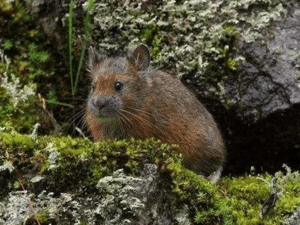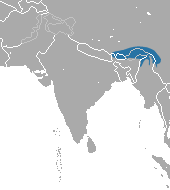Forrest's pika facts for kids
Quick facts for kids Forrest's pika |
|
|---|---|
 |
|
| Conservation status | |
| Scientific classification | |
| Genus: |
Ochotona
|
| Species: |
forresti
|
 |
|
| Forrest's pika range | |
The Forrest's pika (Ochotona forresti) is a small, furry mammal that belongs to the pika family. It lives in the mountains of Bhutan, China, India, and Myanmar. These pikas have dark reddish-brown or blackish-brown fur in the summer. In winter, their fur turns a grayish-brown color. Forrest's pika eats many different types of plants. Scientists first thought this pika might be endangered, but now they believe it is a species of least concern, meaning it is not currently at high risk of extinction.
Contents
What is a Pika?
Forrest's pika is part of the Ochotonidae family, which are small mammals often compared to rabbits, but with short, rounded ears and no visible tail. Their front legs are only a little bit longer than their back legs.
A British zoologist named Michael Rogers Oldfield Thomas first described the Forrest's pika in 1923. He gave it the scientific name Ochotona forresti. For a long time, scientists weren't sure if Forrest's pika was its own species. Some thought it might be a type of Moupin pika or Royle's pika. However, recent studies of their body shapes and DNA show that Forrest's pika is indeed a separate species. It is mostly found in the Gaoligong Mountains.
Some pikas, like the Gaoligong pika and black pika, were once thought to be different species. But now, scientists believe they are actually Forrest's pikas that just have a darker, almost black, fur color.
Appearance of the Forrest's Pika
Forrest's pika looks a bit like a small hare. It measures about 15.5 to 18.5 centimeters (6 to 7 inches) long. It weighs between 110 and 148 grams (about 4 to 5 ounces).
In summer, its fur on its back and belly is a dark reddish-brown or blackish-brown. Its ears are rounded, measuring about 1.8 to 2.3 centimeters (0.7 to 0.9 inches) long. They often have dark gray spots on the back. Sometimes, these spots form a collar around the neck and even reach the face, but the forehead stays brown. The top of their ears is light chestnut with a white edge.
In winter, the fur on its back becomes grayish-brown. This is a bit lighter than the fur on its belly. Its feet are a dull white color. The front claws are long, and the hind feet are about 2.7 to 3 centimeters (1 to 1.2 inches) long.
The Moupin pika is similar to Forrest's pika. However, the Moupin pika has lighter fur on its belly and shorter front claws. Its skull is also narrower, especially across the cheekbones.
Where Forrest's Pika Lives
Forrest's pika can be found in the eastern Himalayas and Kangri Garpo mountains. This includes parts of Southwest China (northwestern Yunnan and southeastern Tibet), Bhutan, Northeast India (Arunachal Pradesh and Sikkim), and northwestern Myanmar.
They are often seen in high mountain areas, usually above 3,000 meters (about 9,800 feet) above sea level in places like the Tawang district of India.
These pikas live in high-altitude forests that have a mix of pine and broadleaf trees. They also like shrubland thickets. Sometimes, they are found around piles of rocks. They usually prefer mountain slopes that face south, at elevations from 2,600 to 4,400 meters (about 8,500 to 14,400 feet) above sea level.
Forrest's pika is quite rare. It is one of six pika species that live only in central China. Scientists don't have many studies about how many of them there are.
Behavior and Life Cycle
Forrest's pika is a herbivore, meaning it eats plants. It eats many different kinds of plants. Not much is known about how it behaves or how it lives its life. Scientists think that Forrest's pika might dig burrows, which are underground tunnels. Very little is known about how they reproduce or raise their young.
Conservation Status
In 1994, scientists didn't have enough information about Forrest's pika to know its conservation status. In 1996, it was listed as near threatened. This means it was close to being considered threatened.
However, after new assessments in 2008 and 2016, Forrest's pika was rated as a species of least concern. This means it is not currently at high risk of extinction. Even though scientists are not sure if its population is growing or shrinking, it is not declining fast enough to be considered threatened.
There are no major known threats to the Forrest's pika population right now. However, it could be affected by the loss of its mountain forest homes in the future. The Chinese regional Red List still describes the species as near threatened.


